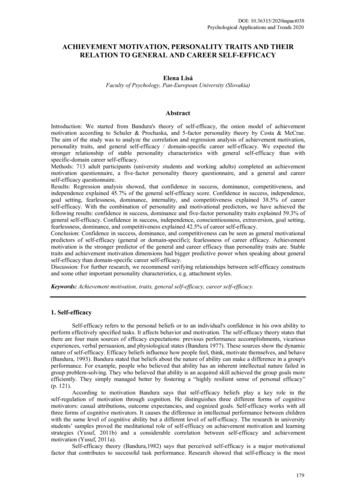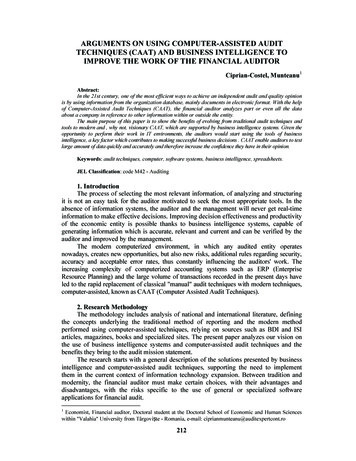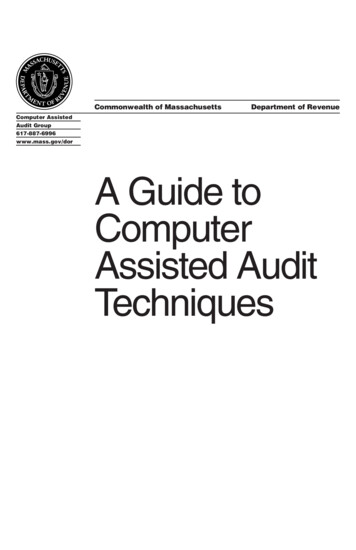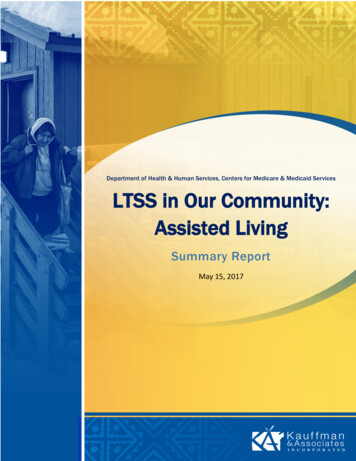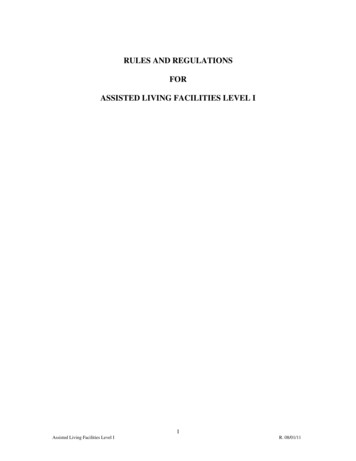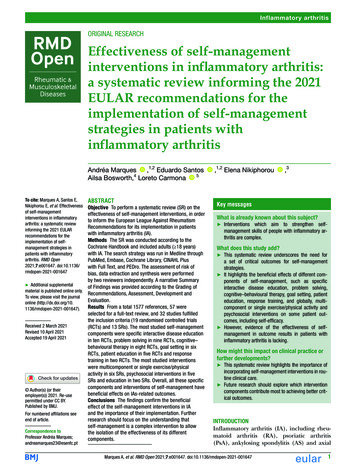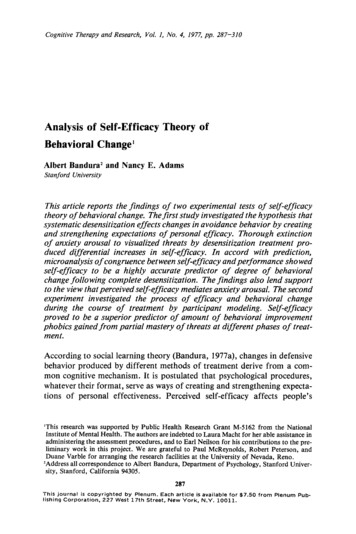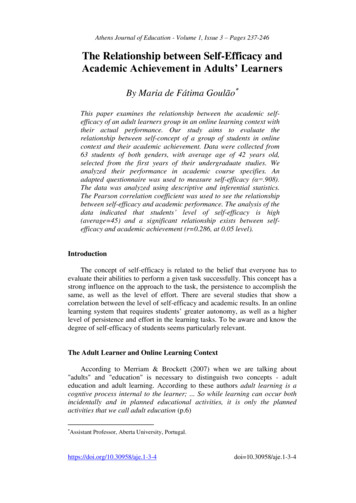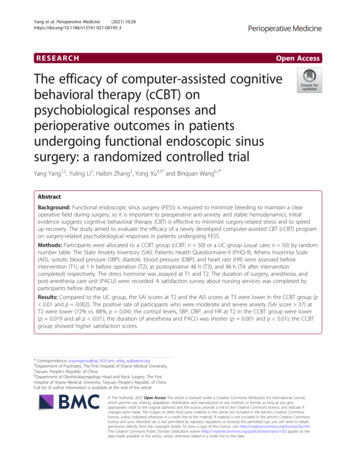
Transcription
Yang et al. Perioperative Medicine(2021) EARCHOpen AccessThe efficacy of computer-assisted cognitivebehavioral therapy (cCBT) onpsychobiological responses andperioperative outcomes in patientsundergoing functional endoscopic sinussurgery: a randomized controlled trialYang Yang1,2, Yuling Li2, Haibin Zhang3, Yong Xu4,5* and Binquan Wang6,7*AbstractBackground: Functional endoscopic sinus surgery (FESS) is required to minimize bleeding to maintain a clearoperative field during surgery, so it is important to preoperative anti-anxiety and stable hemodynamics. Initialevidence suggests cognitive behavioral therapy (CBT) is effective to minimize surgery-related stress and to speedup recovery. The study aimed to evaluate the efficacy of a newly developed computer-assisted CBT (cCBT) programon surgery-related psychobiological responses in patients undergoing FESS.Methods: Participants were allocated to a CCBT group (cCBT; n 50) or a UC group (usual care; n 50) by randomnumber table. The State Anxiety Inventory (SAI), Patients Health Questionnaire-9 (PHQ-9), Athens Insomnia Scale(AIS), systolic blood pressure (SBP), diastolic blood pressure (DBP), and heart rate (HR) were assessed beforeintervention (T1), at 1 h before operation (T2), at postoperative 48 h (T3), and 96 h (T4: after interventioncompleted) respectively. The stress hormone was assayed at T1 and T2. The duration of surgery, anesthesia, andpost-anesthesia care unit (PACU) were recorded. A satisfaction survey about nursing services was completed byparticipants before discharge.Results: Compared to the UC group, the SAI scores at T2 and the AIS scores at T3 were lower in the CCBT group (p 0.01 and p 0.002). The positive rate of participants who were moderate and severe anxiety (SAI score 37) atT2 were lower (72% vs. 88%, p 0.04); the cortisol levels, SBP, DBP, and HR at T2 in the CCBT group were lower(p 0.019 and all p 0.01); the duration of anesthesia and PACU was shorter (p 0.001 and p 0.01); the CCBTgroup showed higher satisfaction scores.* Correspondence: xuyongsmu@vip.163.com; wbq xy@sxent.org4Department of Psychiatry, The First Hospital of Shanxi Medical University,Taiyuan, People’s Republic of China6Department of Otorhinolaryngology Head and Neck Surgery, The FirstHospital of Shanxi Medical University, Taiyuan, People’s Republic of ChinaFull list of author information is available at the end of the article The Author(s). 2021 Open Access This article is licensed under a Creative Commons Attribution 4.0 International License,which permits use, sharing, adaptation, distribution and reproduction in any medium or format, as long as you giveappropriate credit to the original author(s) and the source, provide a link to the Creative Commons licence, and indicate ifchanges were made. The images or other third party material in this article are included in the article's Creative Commonslicence, unless indicated otherwise in a credit line to the material. If material is not included in the article's Creative Commonslicence and your intended use is not permitted by statutory regulation or exceeds the permitted use, you will need to obtainpermission directly from the copyright holder. To view a copy of this licence, visit http://creativecommons.org/licenses/by/4.0/.The Creative Commons Public Domain Dedication waiver ) applies to thedata made available in this article, unless otherwise stated in a credit line to the data.
Yang et al. Perioperative Medicine(2021) 10:28Page 2 of 10Conclusion: The newly developed cCBT program was an effective non-pharmacological adjunctive treatment forimproving the surgery-related psychosomatic responses and perioperative outcomes.Trial registration: The study was registered with the Chinese Clinical Trial Registry (ChiCTR1900025994) on 17September 2019.Keywords: Computer-assisted cognitive behavioral therapy, Psychobiological response, Functional endoscopicsinus surgery, Anxiety, Insomnia, CortisolBackgroundChronic rhinosinusitis (CRS) is a chronic local inflammatory disease with a relatively high incidence. Theoverall prevalence of CRS was 8.0% in seven cities inmainland China (Shi et al. 2015). Once CRS becomesrefractory and no longer responsive to medication, functional endoscopic sinus surgery (FESS) represents thefirst choice for surgical treatment (Kaper et al. 2020).Minimizing blood loss and achieving the optimalintraoperative surgical field visibility are two importantdeterminants of surgical success and outcome in FESS(Chhabra et al. 2020). Perioperative hemodynamicmanagement can optimize surgical conditions, minimizebleeding, and optimize patient outcomes in FESS(Martin et al. 2020). Preoperative anxiety influencesphysiological outputs including increased heart rate, decreased heart rate variability, blunted post-stress systolicblood pressure recovery, and elevated levels of cortisol(Epel, 2020, Landon et al. 2019).The studies on controlled hypotension and reducingintraoperative bleeding are mainly focused on thecomparison of total intravenous anesthesia (TIVA) andinhalational anesthesia (IA) (Lu et al. 2020) and the useof drugs (Chhabra et al. 2020). To minimize the adversereaction, using properly non-invasive and nonpharmaceutical healing techniques may be an additionalapproach. And the perioperative psychological interventions based on multidisciplinary therapy have proved tobe an effective and adequate strategy (Visioni et al.2018). The cognitive-behavioral therapy in psychologicalinterventions was proved to influence positively onmodulating the surgical stress response and improvingsurgical outcomes, particularly in those with maladaptivefeatures (Villa et al. 2020).Cognitive-behavioral therapy (CBT) is the first choicerecommended by the FDA for the non-pharmacologictreatment of depression and anxiety disorders, whichfocuses on correcting maladaptive behavior and negativethoughts (Beck, 1964). CBT had been proved feasibleand acceptable to improve symptoms of depression oranxiety, health-related quality of life (HRQOL) in patients undergoing surgery (Dao et al. 2011). Multiplebarriers prevent patients undergoing major surgery fromaccessing the CBT, such as a shortage of trainedtherapists, high costs, and a lack of accessibility in remote areas, which contribute to lacking patient engagement (Cartreine et al. 2010). The computer-assistedcognitive behavioral therapy (cCBT) had been developedas effective psychotherapy and reveals promise forovercoming barriers in medical settings. cCBT has beensuggested as an attractive alternative treatment to faceto-face treatment, which is a remote mental-health intervention model and presents structured sessions of CBTvia a computer interface or smartphone application(Carlbring et al. 2018). The overall results of RCT suggest that cCBT can be an effective treatment for depression and health anxiety in primary care (Andrews et al.2018). Moreover, it can be a useful adjunct treatment forsomatic conditions with anxiety and depression (Wrightet al. 2018). However, the implementation of cCBT inameliorating negative emotions and somatic distressassociated with surgery is limited. There are few studyreports on cCBT intervention in patients with FESS.Accordingly, the current study aimed to conduct anRCT to test the efficacy of a newly developed cCBTprogram on improving psychological and physical parameters compared to a matched control condition. Thehypotheses of the study are as follows: the patients ofthe CCBT group will express more satisfying subjectiveperception and show objective indications in favor oftreatment and rehabilitation than the control group,such as less preoperative anxiety, postoperative depression, insomnia, cortisol, and more stable hemodynamics(BP and HR).MethodsStudy designThe present study was a prospective, randomized, controlled, and single-blind trial with one experimental arm(CCBT group) and one control arm (UC group). Participants were allocated one of two groups according torandom number table: either five sessions of cCBT orhealth education based on usual care. Participants wererecruited from the Otolaryngology Department throughthe First Hospital of Shanxi Medical University from 20September 2019 to 10 January 2020. The patient, attending anesthesiologist and surgeon were allocated blindlyto the study groups. Surgeons were made up of two teams
Yang et al. Perioperative Medicine(2021) 10:28which were allocated task randomly. Anesthesiologist is aspecialized doctor whose clinical working time is morethan 10 years and responsible for the anesthesia of allparticipants.Anesthesia techniqueThe anesthesia way was TIVA with routine paralysis andendotracheal intubation. Anesthesia was induced withmidazolam (0.03 mg/kg), etomidate (0.3 mg/kg), sufentanil (0.5 μg/kg), and cisatracurium (0.15 mg/kg) to facilitate oral intubation. The anesthesia was maintained witha continuous infusion of propofol infusion (4 6 mg/kg/h) and remifentanil (0.1 0.3 μg/kg/min) by a targetcontrolled infusion (TCI) to maintain bispectral index(BIS) at 40 to 60. A controlled hypotension was providedand adjusted according inter-operative bleeding (target:SBP up to 80 90 mmHg, arterial pressure up to 50 70 mmHg, or a decrease up to 30% than mean arterialpressure) (Modir et al. 2018). The patient was transferred from the PACU to the general ward, if Stewardscore was assessed 4 (or the modified Aldrete scorewas 9) (Sun et al. 2017).Surgical techniqueAfter induction of general anesthesia, local anesthesiaand epinephrine 1:1000 soaked cotton wool pledgetswere applied the nasal cavity for 5 to 10 min to reducebleeding. The surgical technique consisted of bilateralanterior and posterior ethmoidectomy with bilateralmiddle meatotomy according to Messerklinger technique developed by Professor Walter Messerklinger,which only the Ostiomeatal Complex (OMC) lesionswere removed without damage to the mucosa in thesinuses(Kane, 2020).ParticipantsInclusion criteria were the following: (1) aged 18 60years; (2) scheduled to undergo FESS within a week; (3)general anesthesia can be acceptable as a form ofanesthesia; (4) American Society of Anesthesiologists(ASA) grades I and II; (5) be willing to answer the questionnaires and participate in the interventions. Exclusioncriteria included the following: (1) diagnosis of definitehistory of psychiatric illness, substance abuse/dependence within 12 months before enrollment; (2) undergoing a surgery that was postponed for more than a weekor changed to emergent surgery; (3) currently receivingany psychiatric or psychological treatment, includingpsychiatric medication; (4) the Patient Health Questionnaire Depression Scale-9 (PHQ-9) score 20 or the riskof suicide (5) those who had serious cardiovascular andrespiratory diseases.Page 3 of 10Measures and outcomesParticipants were identified and confirmed fromsurgical-plan lists by the Electronic Medical RecordSystem. Then, they were approached by researchers andwritten informed consent would be obtained accordingto the ethical requirements before any study procedure.The participants who met the inclusion criteria wereenrolled and assessed to collect demographic information and baseline data. Two study staff were blinded tocollect and analyze data separately.Baseline characteristics included sex, age, education,principal diagnosis, surgery type, and anesthesia grading.The baseline measures (anxiety, depression, insomnia,stress hormones, vital signs) were collected on the dayafter hospitalization (before intervention: T1). The stateanxiety, stress hormones, and vital signs were reobtained from patients 1 h before surgery (T2). Thedepression, insomnia, and vital signs were re-assessed atpostoperative 48 h (T3). After all interventions are completed, anxiety, depression, insomnia, and vital signswere re-assessed at postoperative 96 h (T4). And a satisfaction survey about nursing services was completed byparticipants before discharge. The duration of surgery,anesthesia, and post-anesthesia care unit (PACU) wererecorded.State-Trait Anxiety Inventory (STAI) was developedby Spielberger C.D and Gorsuch R.L (Spielbergeret al. 1983). State Anxiety Inventory (SAI) assessescurrent state of anxiety at a particular moment andTrait Anxiety Inventory (TAI) evaluates relativelystable aspects of “anxiety proneness” (Spielbergeret al. 1983). These scale were reliable, and Cronbach’salpha 0.80 and 0.85 for SAI and TAI for thecurrent sample. Past studies displayed that SAI score 37 was considered to be moderate and severe anxiety (Pan et al., 2018).The Patient Health Questionnaire Depression Scale-9(PHQ-9) can establish grade depressive symptomseverity (Kroenke et al. 2001). We obtained a value ofCronbach’s α was 0.80 for the current sample. AthensInsomnia Scale (AIS) was developed by Soldatos toquantify sleep difficulty based on ICD-10 criteria (Soldatoset al. 2000). Cronbach’s α was 0.90 for the current sample.The PHQ-9 score 4 and the AIS score 5 were considered a depression or insomnia clinical cutoff state(Kroenke et al. 2001, Soldatos et al. 2003).We collected venous blood of a part of participants(60/100) between 6:00 a.m. and 8:00 a.m. to assay serumcortisol and Adrenocorticotropic Hormone (ACTH) atT1 and T2 respectively. A single venipuncture collected5 8 ml blood into purple and yellow plain tubes (withcoagulants and separation gel). The cortisol and ACTHlevels were measured by chemiluminescence assay(CLIA) and microparticles CLIA.
Yang et al. Perioperative Medicine(2021) 10:28Study interventionsIntroductionThe potential participants were given a brief introduction about the study program before beginning the fivesession intervention, especially the importance of mentalhealth for postoperative recovery. Eligible in-patientswho were willing to participate were registered and keptin touch by study staff.CCBT program interventionThe new cCBT program named “computer-assistedpsychosomatic cognitive behavioral therapy duringperioperative period (CPCBT-Period)” was developedand optimized based on Enhanced Recovery AfterSurgery (ERAS), nursing education and CBT theory. TheCCBT group received the optimized cCBT interventionin addition to usual care. The cCBT is a non-internetbased computer program that includes registration andtherapy conducted in a medical setting. The program isbased on condition-surgery and CBT elements, whichcomprised five sessions, and each session took about 20min to complete. The preoperative preparation time isusually only 3 ( 1) days for patients with FESS since admission and postoperative recovery time is about 7 ( 2)days. The time points of intervention are 2 days and 1day before surgery and 2 days, 3 days, and 4 days aftersurgery. All sessions would finish before discharge. Participants in the CCBT group entered their informationinto the program and the first treatment was administered soon after registration. Each session starts bylogging into the admission number. Next time loggingin, individualized treatment will continue. The treatmentmodules within the program included cognitive therapy,cognitive consolidation, and behavioral relaxation therapy. The contents of perioperative education werereviewed and passed by clinical nursing specialists whichwere unique and customized for surgical patients. Theprimary components of the cognitive therapy module included the following:Session 1: Preoperative psychological preparation;Session 2: Preoperative physical preparation andintroduction to the surgical environment;Session 3: Management of postoperative pain,insomnia, and anti-thrombus;Session 4: Postoperative exercise and diet;Session 5: Education on steps following hospitaldischarge.The behavioral therapy module included relaxingtraining, such as imaginative relaxing exercise, progressive muscle relaxation, breathing exercises, relaxing sleepexercise, and a mindfulness meditation body scan.Homework as cognitive consolidation was then providedfor participants to answer questions in the form of agame, in which the questions served as a review of thePage 4 of 10previous cognitive therapy module. The cognitive therapy module and behavioral therapy module were presented via video. The contents and design were reviewedand passed by psychotherapists.Usual care interventionIn the UC group, patients were administered the FESSroutine care conducted according to the PerioperativeCare Manual and Consensus on ERAS (Chen Bing,2018). To match the CCBT group, participants randomized to this condition, including five sessions, focused oneducation about the illness, surgery, anesthesia, andpostoperative nursing. These sessions were developed inconsultation with clinical nursing specialists. A 20-minverbal briefing per session was administered to participants by study staff. Topics included the introduction ofillness and surgery; preoperative psychological and physical preparation; postoperative disease care; activities anddiet after surgery; and education on steps following hospital discharge.Data analysisTo have a difference greater than 5 in average levels ofstate anxiety between groups used PASS11.0, we estimated a sample size of 46 patients per arm accordingto the previous value of the standard deviation σ 10(Ruffinengo et al. 2009). Allowing for a 10% dropout rate,approximately 50 cases were ultimately included pergroup.Analyses of the outcomes were conducted by IBMSPSS Statistics, version 23.0 (2010 SPSS Inc., IBM Company, Armonk, NY, USA). Descriptive statistics (percentages, means, and standard deviations [SD]) were used tosummarize baseline participant characteristics andscores on the self-report measures. Chi-square and Student’s t tests were performed to test differences ofbetween-group. The repeated-measures ANOVA modelswere conducted to analyze the changes from baseline inthe outcome measures. Median and interquartile intervals were used to describe data of non-normal distribution (Satisfaction) and the Wilcoxon rank-sum test wasused for comparisons between groups. All of the testswere two-sided, and statistical significance was set atp 0.05.ResultsSample characteristicsOne hundred twenty patients were interested in participation and assessed eligibility. Following inclusion andexclusion criteria, finally 100 patients were approachedfor the study. Figure 1 shows the CONSORT flowdiagram, including information about study exclusionand the sample size for analysis. Table 1 summarizes thedemographic data that participants were well-matched
Yang et al. Perioperative Medicine(2021) 10:28Page 5 of 10Fig. 1 CONSORT flow diagramThe results of repeated-measures ANOVA foundgroup*time interaction and time effect for SAI and AISscores was statistically significant (all p 0.01). Furthersimple effect analysis found, to compare with UC group,the mean scores of SAI in CCBT group were lower andhad a difference value 5.04 (95% CI 7.50, 2.54) and5.64 (95% CI 8.01, 3.02) at T2 and T3 (all p 0.01).The mean scores of AIS in CCBT group were lower andhad a difference value 1.26 (95% CI 2.05, 0.47) and1.26 (95% CI 2.09, 0.50) at T3 and T4 (all p 0.01).For PHQ-9 scores, group*time interaction was not statistically significant (p 0.06) and time effect was statistically significant (p 0.01) (see Table 2).Table 1 Characteristics of the study populationThe comparison about the positive rate of participantsin terms of baseline characteristics between the twogroups.Comparative analysis between two groups on the SAI,PHQ-9, and AIS scoresVariableUC group(n 50)CCBT group(n 50)pAge (mean SD)43.08 12.5142.10 12.890.70Men25 (50.00)22 (44.00)0.55Women25 (50.00)28 (56.00)Gender (%)Education (%)High school graduate36 (72.00)37 (74.00)Non-graduates14 (28.00)13 (26.00)TAI (mean SD)34.50 8.0135.18 9.510.820.87Diagnosis (%)CRS with NP26(52.00)30(60.00)CRS (only)20(40.00)15(30.00)Other4(8.00)5(10.00)The results of the comparison about positive rate of participants who were moderate and severe anxiety (SAI score 37) illustrated that the difference was statistically significantbetween the two group (72% vs. 88%, p 0.04). The resultsof the comparison about positive rate of participants whowere insomnia (AIS score 5) illustrated that the differenceafter intervention was statistically significant between thetwo groups (4% vs 22%, p 0.01), while the results showno difference about the positive rate for depression (PHQ-9 4) between two groups (Fig. 2).0.574All values are mean SD or number (proportion). TAI Spielberger Trait AnxietyInventory. CRS with NP chronic rhinosinusitis with nasal polyps, CRSchronic rhinosinusitisThe comparison about duration of surgery, anesthesia,and PACU between-two groupsThe duration of surgery between-two groups had nodifference significantly (p 0.583). The duration ofanesthesia and PACU in the CCBT group were shorterthan that of the UC group (p 0.001 and p 0.001)(see Table 3).
(2021) 10:28Yang et al. Perioperative MedicinePage 6 of 10Table 2 Between-group differences on study outcome measuresMeasuredUC group (n 50)CCBT group (n 50)Difference (95% CI)p32.02 5.8933.12 6.801.10 ( 1.35, 3.61)0.39SAIT1T244.80 7.0639.76 4.95 5.04 ( 7.04, 2.63) 0.01T428.98 5.47e,f23.34 3.37e,f 5.64 ( 7.44, 3.84) 0.01abpe 0.01ec 0.01 0.01PHQ-9T13.40 3.263.14 2.48 0.26 ( 1.32, 0.92)0.66T33.98 2.914.18 2.50 0.20 ( 1.26, 0.98)0.712.08 1.901.98 1.730.10 ( 0.94, 1.31)0.780.81a 0.01 b0.06cT4pAIST1p3.16 2.443.60 2.160.44 ( 0.47, 1.34)0.91T36.16 2.214.90 1.73 1.26 ( 2.05, 0.47)0.002T43.18 2.22g1.92 1.86e,g 1.26 ( 2.07, 0.45)0.003ea0.005e 0.01bc 0.01SAI State Anxiety Inventory, PHQ-9 Patient Health Questionnaire Depression Scale-9 item, AIS Athens Insomnia Scale, T1 before the intervention, T2 at 1 h beforesurgery, T3 at postoperative 48 h, T4 at postoperative 96 h (after the intervention completed)ap value of group effectbp value of time effectcp value of interactive effects between time and groupdp value adjusted by Bonferroni methodeCompared with the T1, p 0.05, adjusted by Bonferroni methodfCompared with the T2, p 0.05, adjusted by Bonferroni methodgCompared with the T3, p 0.05, adjusted by Bonferroni methodThe comparison of Cortisol and ACTH levels between-twogroupsThe cortisol level of the UC group were significantlygreater at T2 compared to T1 (p 0.001). At T2, thecortisol level were higher significantly in the UC groupthan that of the CCBT group (p 0.02) (see Table 4).The change trend comparison about SBP, DBP, and HRThe change trend comparison about SBP, DBP, and HRbetween two groups found that the trend for CCBTgroup was more stabilized than the UC group. More importantly, at 1 h before surgery, the SBP mean value inCCBT group was lower than that of the UC group(127.24 16.27 vs 146.06 20.59, p 0.01), the sameFig. 2 The comparison about the positive rate of participantswith the DBP mean value (78.48 11.42 vs 87.86 13.31, p 0.01) and the HR mean value (79.90 10.73vs 90.42 12.83, p 0.01) (Fig. 3).Satisfaction survey comparisons between two groupsParticipant satisfaction was significantly higher in theCCBT group than in the UC group for all of the assessedcategories except disease care (p 0.12) before dischargecare item (Table 5).DiscussionIn the present study, we aimed to explore the efficacy ofan optimized five-sessions cCBT for individuals withFESS who had psychobiological responses because of
Yang et al. Perioperative Medicine(2021) 10:28Page 7 of 10Table 3 The duration comparative analysis between two groups(mean SD)Duration (min)UC group (n 50)CCBT group (n 50)pSurgery137.78 18.41139.80 18.250.58Anesthesia214.68 20.55199.24 22.790.001PACU32.20 8.8422.98 8.26 0.01PACU post-anesthesia care unit, Duration of anesthesia time between the induction and leaving from PACU, Duration of surgery time between touching the skinand the end of suture or tamponade, Duration of PACU time between PACU admission to dischargesurgery. The intervention appeared to be useful not onlyin improving anxiety and insomnia, but also in biologicalparameters (cortisol, hemodynamic control) comparedto the control group. However, there were few RCTs reported about cCBT treating FESS patients with psychological distress. The present study provides preliminarydata to assess the potential efficacy and mechanism ofmobile technology-based cCBT interventions in clinicalsurgery applications.In the present study, the anxiety level increased beforesurgery in both groups. The causes may be the lack ofan adequate preoperative education, awareness of theprocess of surgery and anesthesia, and uncertaintiesabout postoperative steps and worrying about the outcomes. The newly cCBT based on nursing education canhelp patients to know surgery and anesthesia adequately,and preview postoperative rehabilitation in advance. Theresult showed the CCBT group experienced a lower levelof anxiety and insomnia than the control group. The improvement in insomnia may be affected by the improvement of anxiety. The results were consistent with theresults of recent meta-analyses, and cCBT was found toimprove self-reported psychological outcomes (anxietyand depression) and physical outcomes (pain and insomnia) of patients with psychiatric and somatic disorders(Mehta et al. 2019). However, no significant effects wereobserved for depression symptoms between the twogroups. It may be due to surgery-related stress being experienced on a short-term timescale, while depressionmay exhibit a more extended time course (Yang et al.,2015). The mechanisms that psychological interventionscan influence anxiety in surgery patients may be affectedunderlying the neuroendocrine response to surgicalstress (Villa et al. 2020).The surgery-related perioperative stress may affect extensively patients’ neuroendocrine pathways (Madukaet al. 2015). Enhanced cognitive coping may modulatehypothalamic-pituitary-adrenal (HPA) axis activity andimprove the levels of endocrine hormones (Abelsonet al. 2008). Anxiety can increase the cortisol secretion,which has been observed among patients awaiting operation. The newly developed cCBT based on CBT andnursing education can significantly reduce cortisol levelsof the CCBT group, which may be due to cognitive biasmodification and behavioral coping in CBT. Cortisolhomeostasis is essential for cognitive and affective functions (O'Connor et al. 2021). Increased cortisol and animbalance of the HPA axis can contribute to the development of anxiety and depression (van Dalfsen andMarkus, 2018). The differences of ACTH were not observed and it may illustrate that ACTH is not a sensitiveindex related-surgery stress than cortisol. The connection among emotions, hormones, and brain networks isthe basis for subsequent research.Numerous studies and meta-analyses have linked BPresponses to mental stress to poor health outcomes(O'Connor et al. 2021). Generally, anxiety increasesblood pressure, systemic vascular resistance, sympatheticactivity (Pan et al. 2015). Preoperative stablehemodynamics contributes to control hypotension andreduce intraoperative bleeding which help to completethe surgery smoothly and lighten the burden on theanesthesiologist. Gu et al. in their study relieved anxietyand stabilized BP and HR by dexmedetomidine combined with parecoxib before anesthesia induction in patients for FESS (Gu et al., 2020). In this study, thepatients in the CCBT group had a lower preoperative BPand HR, which showed cCBT can help anesthesiologistscontrol high BP and HR using minimal drugs. Theshorter duration of anesthesia and PACU illustrated patients using cCBT program experienced shorter durationof anesthesia induction and faster postoperative recoverytime. These are key factors of improved perioperativeoutcomes and can also ease the burden for anesthetistsTable 4 Cortisol and ACTH comparative analysis between two groups(mean SD)MeasureUC (n 30)CCBT (n 30)T1T2T1T2Cortisol (nmol/L)295.43 125.66349.57 83.39Δ*307.07 111.92306.22 74.86ACTH (pg/mL)38.17 17.4040.57 13.4137.39 24.7039.55 20.30T1 before the intervention, T2 at 1 h before surgery*p 0.05, p value of independent-samples t testΔp 0.05, p value of paired t test
Yang et al. Perioperative Medicine(2021) 10:28Page 8 of 10Fig. 3 The change trend line chart of BP and HR(Sgrò et al. 2019), while the duration of surgery was nodifference between two groups, which may be related todifferent surgeons. In the present study, cCBT had apositive effect on stabilizing hemodynamics beforeanesthesia induction, but had a limited impact on vitalsigns during the postoperative recovery period.Making the patient safe and comfortable during thewhole perioperative period is our medical aim. Satisfaction scores were universally high in the CCBT group.However, differences in Disease Care item was not observed, which may be correlated to accept standardnursing procedures. The patients participating in theCCBT group indicated that they received more services,especially psychological services. The more satisfactorymedical experience makes the relationship betweenmedical staff and patients harmonious and reduces theincidence of violence (Meng et al. 2020).The study had several limitations. Firstly, the intervention was conducted at a single site, with a relativelysmall sample size, and only a part of participants werewilling to be blood collected, which may have been insufficient and subject to type II errors during analysis.Secondly, our study did not assess the long-term effectsin patients, which can be rectified in a future study thatcontinues to follow up on these patients and collectadditional data. Thirdly, we did not measure intraopblood loss or surgeon’s satisfaction of a bloodless field,which are important measures to evaluate the successof
2018). The cognitive-behavioral therapy in psychological interventions was proved to influence positively on modulating the surgical stress response and improving surgical outcomes, particularly in those with maladaptive features (Villa et al. 2020). Cognitive-behavioral therapy (CBT) is the first choice recommended by the FDA for the non .



